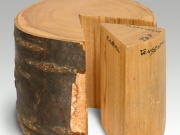Difference between revisions of "Radial"
Jump to navigation
Jump to search
(username removed) |
m (Text replace - "== Authority ==" to "== Sources Checked for Data in Record ==") |
||
| Line 4: | Line 4: | ||
For wood, a radial cut follows the longitudinal grain and is perpendicular to the growth rings. Radial cuts on a cake would produce a set of pie-shaped pieces. Growth rings are seen as parallel lines and rays are seen as streaks. | For wood, a radial cut follows the longitudinal grain and is perpendicular to the growth rings. Radial cuts on a cake would produce a set of pie-shaped pieces. Growth rings are seen as parallel lines and rays are seen as streaks. | ||
| − | == | + | == Sources Checked for Data in Record == |
* ''Encyclopedia Britannica'', http://www.britannica.com Comment: Wood. Encyclopædia Britannica. Retrieved June 24, 2004, from Encyclopædia Britannica Premium Service. | * ''Encyclopedia Britannica'', http://www.britannica.com Comment: Wood. Encyclopædia Britannica. Retrieved June 24, 2004, from Encyclopædia Britannica Premium Service. | ||
Revision as of 17:49, 1 May 2016
Description
For wood, a radial cut follows the longitudinal grain and is perpendicular to the growth rings. Radial cuts on a cake would produce a set of pie-shaped pieces. Growth rings are seen as parallel lines and rays are seen as streaks.
Sources Checked for Data in Record
- Encyclopedia Britannica, http://www.britannica.com Comment: Wood. Encyclopædia Britannica. Retrieved June 24, 2004, from Encyclopædia Britannica Premium Service.
- R. Bruce Hoadley, Identifying Wood, The Taunton Press, Newton, CT, 1990
